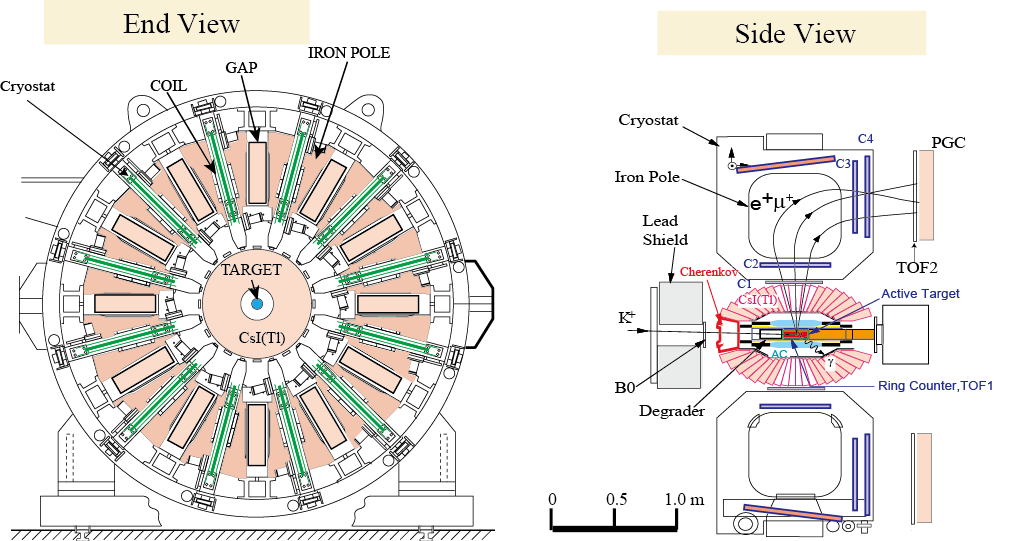Detector overview
Abstract
This experiment will be performed at J-PARC employing a stopped K+ beam in conjunction with a 12-sector iron-core superconducting toroidal spectrometer. The Ke2 (Pe+ = 247 MeV/c) and Kμ2 (Pμ+ = 236 MeV/c) events will be accepted by analyzing charged particle momenta using the spectrometer. In order to compare the experimental RK value with the SM prediction, the internal bremsstrahlung process in radiative K+ → e+νγ (KIB e2γ) and K+ →μ+νγ (KIB μ2γ) decays has to be included into the Ke2 and Kμ2 samples, respectively. Schematic cross sectional side and end views of the detector system are shown in the followings. The RK value is derived from the numbers of the accepted Ke2 and Kμ2 events by correcting for the detector acceptance.

Figure caption: Cross sectional end and side views of the setup for the RK experiment and the heavy neutrino search.
Overview
A separated 800-MeV/c K+ beam is extracted using the J-PARC K1.1BR beam line. The beam is slowed down by a degrader and stopped in a position-sensitive fiber target. Charged particles from the target are tracked and momentum-analyzed using one GEM detector (C1) and three multi-wire proportional chambers (C2, C3, C4 ) in each toroidal sector. The Ke2, Kμ2, and their radiative decays are collected for central magnetic field of the spectrometer, B = 1.4 T. The C1 element is placed at the outer surface of the muon hole of the CsI(Tl) calorimeter. The C2 and C3- C4 chamber are set at the entrance and exit of the magnet gaps, respectively. In order to remove Ke3 and Kμ3 backgrounds, Ke2 and Kμ2 events are identified by requiring the e+ and μ+ momentum to be higher than the Ke3 and Kμ3 endpoints (PMax e = 228 MeV/c, PMax μ = 215 MeV/c) as shown in this figure. Particle discrimination between e+ and μ+ is carried out using an aerogel Cherenkov counters and a lead-glass Cherenkov counter, and by measuring the time-of-flight (TOF) between the TOF1 and TOF2 scintillation counters. The TOF1 scintillator surrounds the fiber target and TOF2 is located behind C4. The photon detector, an assembly of 768 CsI(Tl) crystals, covers 75% of the total solid angle. Since photons produce electro-magnetic showers, their energy is shared among several crystals. The photon energy and hit position are obtained by summing the energy deposits and by determing the energy-weighted centroid, respectively. The 0γ and 1γ events are accepted as Kl2 or Kl2γ samples.